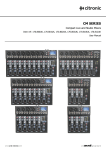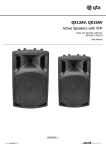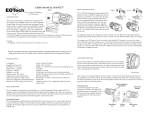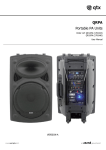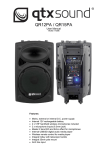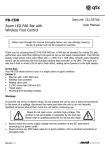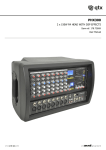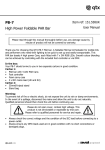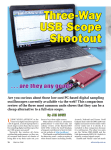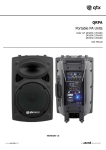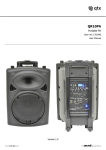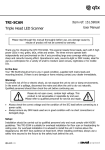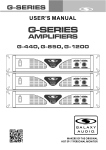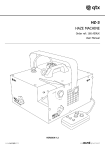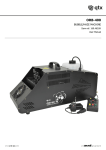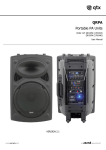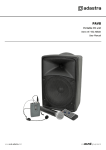Download UHF Wireless Systems User Manual
Transcript
UH5 UHF Wireless Systems User Manual Version 1.0 Caution: Please read this manual carefully before operating Damage caused by misuse is not covered by the warranty Introduction Thank you for choosing the QTX Sound UH5 wireless system. This professional wireless set provides a high quality microphone with UHF radio system for freedom of movement without loss of audio quality. Please read this manual before using this equipment in order to avoid damage through incorrect operation and to get the best performance from your purchase. Contents: Please take care when unpacking this product. Inspect for any damage and ensure you have the following components… UHF wireless receiver Mains power adapter 6.3mm mono jack lead 2 x AA batteries Handheld UHF microphone transmitter Warning To prevent the risk of fire or electric shock, do not expose any of the components to rain or moisture. If liquids are spilled on any component, stop using immediately, allow unit to dry out and have checked by qualified personnel before further use. Avoid impact or heavy vibration to any of the components, dropping the microphone can cause capsule failure. No user serviceable parts inside transmitter or receiver - refer servicing to qualified service personnel. Safety Ensure that the correct adapter is used with adequate current rating and that the mains voltage is as stated on the adapter. Avoid ingress of water or particles into the transmitter or receiver Use alkaline or NiMH batteries in the transmitter and remove if unused for long periods. Observe the correct polarity when replacing batteries Placement Keep all components out of direct sunlight and away from heat sources. Do not place heavy objects on top of the receiver or transmitter Keep the transmitter and receiver away from damp or dusty environments. Cleaning Use a soft cloth with a neutral detergent to clean the body of the microphone/transmitter and receiver. Lightly damp sterile wipes may be used on the microphone grille for hygiene purposes To avoid damage, do not use solvents to clean the components 171.802UK User Manual Handheld Transmitter Receiver Rear Panel 1. Windshield 2. Slide switch and LED 3. Battery compartment 4. 5. 6. 7. Unbalanced jack output Balanced XLR output DC power inlet Antenna Receiver Front Panel 8. 9. 10. 11. Power ON/OFF switch RF carrier indicator AF audio level indicator Output level control Operation Insert the supplied AA batteries by carefully sliding the rear battery compartment cover downwards to reveal the compartment and install the batteries by sliding the first one to the top and inserting the second battery behind it, taking care to observe the correct polarity. Position the receiver within the best available line of sight to the transmitter and turn down the output level control. Connect the DC jack of the supplied power adapter to the receiver and the plug-top to the mains outlet. Extend the antenna upwards and outwards slightly and switch the power on. Connect the jack or an XLR (optional) lead to the receiver’s audio output connector, turn down the volume of any equipment (mixer, amplifier etc.) that the signal will be fed into and then connect the jack or XLR to the equipment. Warning! - take care not to point microphones towards speakers – this can cause damaging feedback (loud whistle or howling noise) – try to point microphones away from the speaker cabinets. Move the switch on the handheld or bodypack transmitter to the first notch (MUTE) – the LED should light momentarily (continuous dim LED indicates low battery). Move on another notch (ON) and gradually increase the microphone level(s) on the receiver, then increase the volume on the mixer or amplifier until the sound from the microphone can be heard through the equipment. Output level can then be adjusted to the required level from the receiver output level control and the volume controls on the amplifier or mixer. During use, it may be helpful for the reception of the microphone to be muted for a short period of time (e.g. to avoid feedback when walking across the front of a speaker or avoid handling noise when placing the microphone down momentarily or adjusting a neckband microphone). In these circumstances, it may be better to move the transmitter switch to the “MUTE” position, which maintains the radio frequency carrier signal but mutes the microphone input. When this switch is moved back to the “ON” position, the sound will be immediately restored without waiting for the radio signal to be reinstated. 171.802UK User Manual If the wireless system is not to be used for more than a few seconds, it is preferable to slide the transmitter switch to the “OFF” position, which mutes and deactivates the radio signal and powers down the transmitter. Be sure to turn down the volume of the mixer or amplifier and then switch off the receiver. Unplug signal leads from the receiver and mixer or amplifier when moving or packing away. If the system is not to be used for long periods of time, remove the batteries from the transmitter and unplug the power adapter from the receiver and the mains outlet. Retracting the antennae can also help avoid damage when the system is not in use. Specifications Power supply - receiver Power supply - transmitter Current consumption : Handheld Carrier frequency Maximum range Sensitivity Signal to noise ratio THD Output connection Frequency response Dimensions - handheld transmitter Weight - handheld transmitter Dimensions - receiver Weight - receiver 12-18Vdc, 350mA adaptor (included) 3Vdc (2 x AA batteries included) <100mA 864.99MHz 50.0m -105dB @ ±12dB >105dB <0.5% @ 1KHz XLRF or 6.3mm jack 50Hz - 18KHz (±1dB) 265 x 46mmØ 174g (no battery) 209 x 150 x 42mm 390g Troubleshooting “POWER” LED does not light on receiver “POWER” LED is lit but no “SIGNAL” LED LEDs are lit but no sound from microphone Ensure power adapter is connected to mains and working properly Ensure receiver is switched on Ensure transmitter is switched on Check that transmitter is not out of reception range Check that transmitter battery is good / charged Check if transmitter switch is in “MUTE” position Make sure receiver is connected to mixer / amplifier Make sure that amplifier / mixer channel volume is turned up Ensure transmitter has a good / charged battery Check if there is another nearby transmitter with the same frequency Turn down VOLUME on receiver Reduce Gain on mixer / amplifier Ensure that XLR output is not fed to a Line input Turn up VOLUME on receiver Increase Gain on mixer / amplifier Ensure that Jack output is not fed to a Mic input Check transmitter battery Disposal: The “Crossed Wheelie Bin” symbol on the product means that the product is classed as Electrical or Electronic equipment and should not be disposed with other household or commercial waste at the end of its useful life. The goods must be disposed of according to your local council guidelines. 1622 Errors and omissions excepted. Copyright© 2013. AVSL Group Ltd. 171.802UK User Manual





